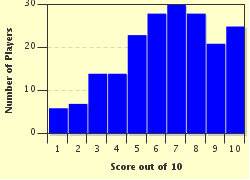Quiz Answer Key and Fun Facts
1. Even a long-ago apocalypse changes the landscape. "A Canticle for Leibowitz," by Walter M. Miller, begins hundreds of years after the nuclear war that returned humanity to the Dark Ages. In the novel, what institution has been responsible for preserving what scientific knowledge remains?
2. It isn't clear what kind of apocalypse set the stage for Suzanne Collins' "Hunger Games" series, but its effects are long-lasting and far-reaching. What type of people does the dystopian government of Panem force into gladiatorial contests?
3. As described by Nevil Shute in "On the Beach" (1957), humanity may not have much time to contemplate life after the end of the world. In the novel, the northern hemisphere has been devastated by nuclear war, and the radioactive fallout is drifting inexorably southward -- leaving no man, woman, or child alive. In preparation for the arrival of certain doom, what does the Australian government distribute to its people?
4. P.D. James imagined a comparatively slow and gentle apocalypse, but "The Children of Men" nonetheless opens on a depressed populace sure that the human race is doomed. Why?
5. The characters of Stephen King's 1978 novel "The Stand" take two very different approaches to post-apocalyptic life. Some survivors join up with Mother Abagail to try to recreate a democratic society; others follow Randall Flagg in building an authoritarian society with a ruthless focus on obedience. In what two U.S. cities do these opposing groups build their strength?
6. In "Pastwatch," the apocalypse comes as a prologue. Orson Scott Card writes of a century of war and famine and disaster that killed nine of every ten human beings and left the rest as a humbled civilization on a critically damaged planet. The survivors' future looks grim enough that they gamble it all on a desperate attempt to remake a better society. How do they plan to do this?
7. In S.M. Stirling's "Dies the Fire," civilization falls on March 17, 1998. Battling disease, starvation and banditry, Juniper Mackenzie and Mike Havel each bring a band of people to relative safety in the fertile Willamette Valley, in western Oregon. What disaster has brought them so low?
8. The Tripods, of John Christopher's "Tripods" series, are aliens who have conquered Earth and enslaved humanity, rolling back civilization. How do they keep the adult human population in line?
9. Climate change has brought civilization to its knees in Octavia Butler's "Parable of the Sower." The protagonist, a teenager named Lauren Oya Olamina, leads a ragtag group of refugees from the ruins of the Los Angeles suburbs to form a community of farming and faith. What is the name of the religion Lauren founds?
10. "The Hitchhiker's Guide to the Galaxy" may not dwell on it much, but it does begin with the total destruction of planet Earth. Why do the Vogons blow up the world?
Source: Author
CellarDoor
This quiz was reviewed by FunTrivia editor
agony before going online.
Any errors found in FunTrivia content are routinely corrected through our feedback system.

